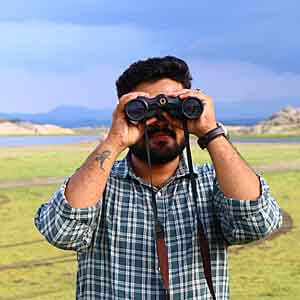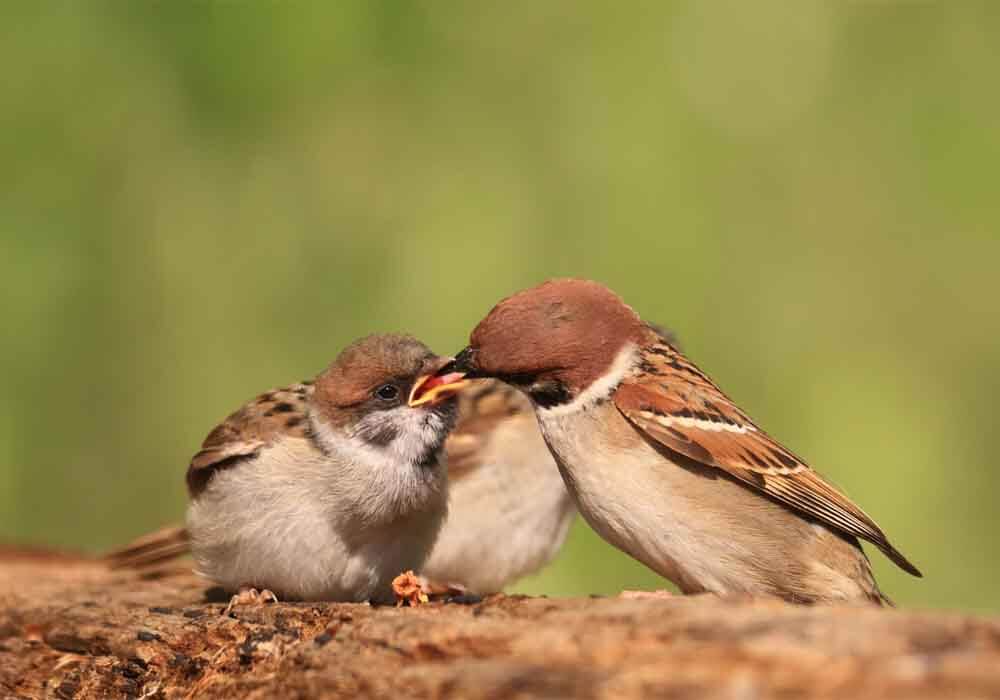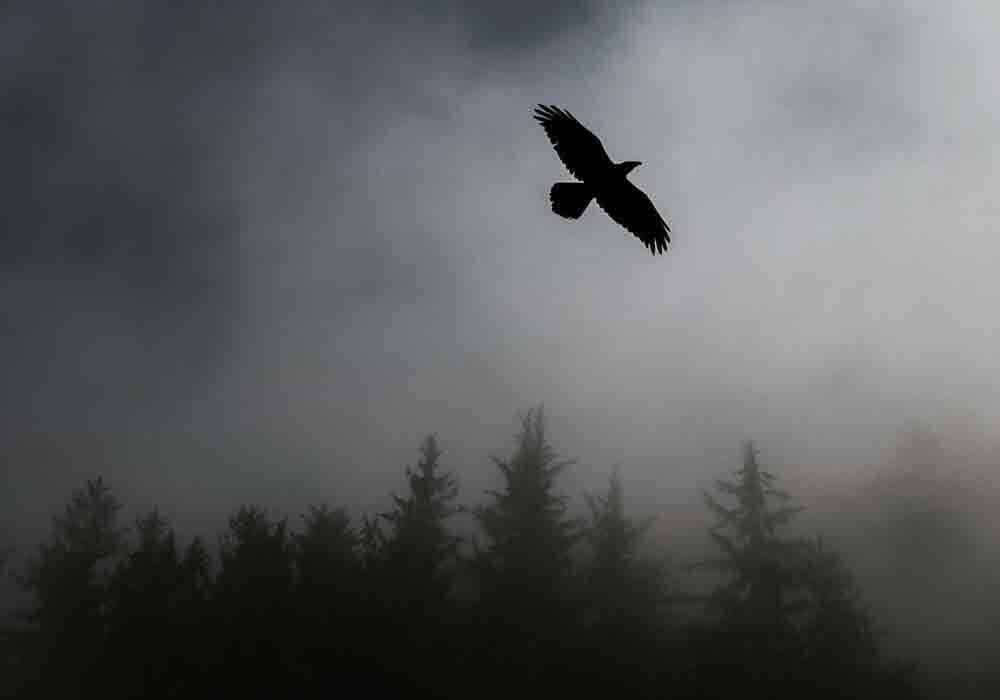How To Remove
a Birds Nest Safely
Even if you're the most ardent bird lover, there are some cases when you'd like to remove a bird's nest, such as if the nest is in an inconvenient place or the birds are in danger. Remember, when learning how to remove a birds nest, this is a process that must be done with care and caution.
To remove a bird's nest, you must first identify the species to ensure that removal is legal. Then, you must wear the proper clothing and safety gear, spray the nest with antibacterial spray, remove it, and dispose of it far away from your house.
In the rest of this article, I'll answer your questions about removing a bird's nest in various circumstances. I'll also discuss the legality of nest removal, so you can avoid getting a hefty fine (or even jail time!). If you have a nest on your property that you want to remove, keep reading!

How To Remove a Birds Nest From a Tree
To remove a bird's nest from a tree, follow these steps:
- Identify the bird's nest to ensure it doesn't belong to a native species. If the nest does belong to a native species, removing the nest is illegal, and you'll have to seek guidance from the U.S. Fish & Wildlife Service or a local bird rescue.
- Wear the proper clothing, including long sleeves, gloves, and a respiratory mask.
- Look in the nest to ensure there aren't any eggs.
- Spray the nest with an antibacterial spray.
- Wait for the spray to dry.
- Set up a ladder to reach the nest in the tree, if necessary.
- Remove the nest and place it into a container with a seal or a trash bag.
- Place the trash bag or the container in an outside garbage bin far away from your house.
- Sanitize the area where the nest was with disinfectant.
- Remove your gloves and throw them away in an outside garbage bin.
- Remove your clothing and wash it immediately.
- Wash your hands with soap and warm water.
If you follow these steps, you can safely and effectively remove a bird's nest. However, if you don't feel comfortable doing this yourself, you can call a professional for help.
Is It Illegal To Remove a Birds Nest?
According to the Migratory Bird Treaty Act of 1918, it is illegal to remove or otherwise interfere with an active nest belonging to a native species of bird. Doing so may result in a fine and a misdemeanor charge.
You may think that if a bird's nest is on your property in an inconvenient place, you can simply remove it. However, in the United States, this is not the case. The 1918 Migratory Bird Treaty Act protects nests from human interference, so if you were to remove a bird's nest from a native species, you could face a misdemeanor charge and a significant fine. In some states, you may even face jail time.
However, the law only protects active nests that belong to native species. Therefore, if the bird's nest is no longer being used, you can legally remove it. Additionally, you may remove the nest if the birds occupying the nest are invasive, such as the house sparrow.
Other invasive species include:
- European Starling
- Common Grackle
- Domestic Pigeon
- Red-winged Blackbird
- Monk Parakeet
- Brown-headed Cowbird
- Canada Goose
- American Crow
You can legally remove the nest if you find nests from any of the above species. However, I recommend calling a bird rescue to have them come and look at the nest and verify that you identified the bird correctly. Additionally, they can remove the nest safely.
A nest is considered active if it has a brooding adult bird or if it has eggs in it. A brooding bird is sitting on and incubating or preparing to lay eggs. If you think a nest is inactive, it is always safest to wait until the end of the breeding season to make sure.
You can also remove nests in birdhouses, but it is best to wait until the end of the breeding season to ensure that no birds are using them.
In some cases, it is better for the birds to move the nest than to leave it. For example, a car's tailpipe or a lawn mower certainly isn't the safest place for a nest, so if a bird builds one there, you should take action. However, you shouldn't try to remove the nest yourself because this is still breaking the law. Instead, call a bird rescue or the United States Fish and Wildlife Service and have them sort out the best course of action.
Is It Safe To Remove a Birds Nest?
Removing a bird's nest is safe as long as you wear the right protective gear and sanitize thoroughly. Birds use many kinds of materials to build their nests that could be harmful and carry diseases.
Birds use many materials to build their nests, including twigs and grasses that would be scratchy or uncomfortable to handle. Even more importantly, the bird droppings in the nest could have bacteria or parasites you don't want to touch or expose yourself to.
If a corpse is in the nest, you face even more problems. Dead birds typically have histoplasmosis, which can cause many diseases in humans. I recommend contacting a professional if you encounter a nest with a dead bird inside.
Therefore, to safely remove a bird's nest, you must wear the proper clothing. Proper clothing includes long sleeves, latex gloves, and a respiratory mask to protect yourself from any fungal spores that may be present. You may feel overprepared for something as small as removing a bird's nest, but better safe than sorry!
I recommend this Ruiqier Respirator Mask from Amazon.com because the sealing edge is made with comfortable elastic silicone that is comfortable on the face, and the mask strap is adjustable to suit any head shape. Additionally, the mask has a double filter system, which blocks 97% of all particles in the air, including possible fungal spores from the bird's nest.
Additionally, you'll need to spray the nest with antibacterial spray before touching it. Then, after removal, you should clean the area with disinfectant. I recommend using the Microban Disinfectant Spray from Amazon. This spray kills viruses following the Environmental Protection Agency Emerging Viral Pathogen policy and effectively kills 99.9% of viruses within a minute.
If you follow these precautions, you can safely remove a bird's nest. However, you can always call a local bird rescue or a wildlife exclusion company for assistance if you don't feel comfortable removing the nest yourself.
How To Remove a Birds Nest With Eggs
Without traumatizing the mother bird, you cannot remove a bird's nest with eggs. Additionally, removing an active nest is illegal in most cases. You'll have to wait until the birds hatch and can fly away.
If you find a nest on your property with eggs already inside, you cannot remove it. In most cases, doing so is illegal, and you risk a misdemeanor charge and a fine if you attempt.
Additionally, interfering with a bird's nest with eggs inside almost certainly ensures the baby birds' demise. Mother birds will know that a human has been near her nest and will abandon the eggs. Then, the babies won't hatch because their eggs won't be incubated, or they will hatch and die shortly after because they don't have anyone caring for them.
If the nest is simply in an inconvenient place, you'll have to wait 6-8 weeks for the birds to vacate. However, if the nest is in a place where the birds are in danger, contact the U.S. Fish & Wildlife Service for guidance.

Want to learn how to move a birds nest and relocate it somewhere else? This article of ours has step by step instructions to guide you.
How To Remove a Birds Nest From a Chimney
Birds regularly build nests in chimneys because they are safe and dry places to raise their young. Removing the nest involves puncturing the nest with a brush to loosen the materials and then sweeping these materials away into a garbage bag.
If you notice twigs and other outside materials in your fireplace, there's a good chance that a bird is nesting there. If the nest is active, you'll have to wait until the end of the breeding season to remove it. If the nest is inactive and ready for removal, follow these steps:
- Wear protective clothing, including gloves, long sleeves, and a respiratory mask.
- Use a small brush or a broom to puncture the nest and loosen the materials.
- Use a chimney sweep to brush the materials away into a garbage bag once they've fallen into the fireplace.
- Secure the garbage bag and place it in an outside garbage bin.
To prevent more birds from nesting in your chimney in the future, I recommend getting a bird-guarding cap to secure your chimney. The bird guards made from stainless steel are durable and last long, keeping your chimney and home safe from birds.
How To Get Rid of a Birds Nest
To get rid of a bird's nest, place it in a garbage bag, seal the bag, and then place it in an outside garbage bin, as far away from your house as possible. This method protects you from possible diseases and bacteria.
Once you've removed the bird's nest from the area, you still need to dispose of it. The best way to do this is to place the entire nest in a secure, exterior garbage bag. I recommend these Aluf Plastics 65 Gallon Trash Bags from Amazon.com because they are made with thick material that won't puncture, even from the sharp twigs and grasses that birds use in their nests. I also like that these trash bags are made in the United States.
Once you have the nest in a closed trash bag, place the trash bag in an outside garbage bin. The further away from your house, the better. In most cases, you'll be okay even if the trash bin is close to your home, but it is better to take extra precautions to avoid disease. how to remove a birds nest
How To Prevent Birds From Building Nests
Removing a bird's nest is often illegal and impossible. However, even if you can remove the nest, doing so is a hassle you probably won't want to deal with again. Luckily, there are ways you can prevent a bird from building a nest around your home, so you never have to worry about removal again.
Here are my recommendations for preventing birds from nesting on your property:
- Keep your garden well-maintained. Overgrown shrubs and bushes are popular places for birds to build nests, so keeping your yard and garden trimmed and pruned can keep birds from nesting in these areas.
- Build a birdhouse. If you can't beat 'em, join 'em, right? Building an attractive birdhouse can encourage them to nest there instead of in an unwanted area if you love birds and want them around but simply want to control where they are.
- Install bird netting. Bird netting is a pest-managing tool that prevents birds from reaching certain areas. I recommend this WOSCMI Bird Netting from Amazon because it is durable and UV resistant, so it will last you a long time. Additionally, it provides maximum protection without harming the birds.
- Use unappealing scents. Some scents are foul to birds, including peppermint and lemon. Therefore, if you make a repellent with these aromas, you're likely to deter birds from setting up a nest near your home.
- Use shiny objects. Birds are frightened of bright, shiny objects such as CDs and mirrors, so if you deploy these around your yard, you'll probably scare them away. Make sure you place these objects where they'll get a lot of sun for the best results.
If you follow these tips, you're unlikely to experience birds building nests.
How To Remove A Birds Nest...Conclusion
Removing a bird's nest is generally not recommended and is often illegal. However, there are some times when it is necessary, such as when the birds are in a dangerous place. If you have to remove a bird's nest, wear the proper clothing and proceed carefully because it can be an unsafe process. Then, dispose of the nest in a secure garbage bag in an outside garbage bin.
Back To The TOP Of This How
To Remove A Birds Nest Page

About the Author...
Richard Worden, a dedicated bird lover for over 20 years, I love to share my in-depth knowledge and passion for birds. Read more About Me and my expertise in this field.
- We Know Birds HOME ›
- Bird Facts and Information ›
- How to Remove A Birds Nest Safely



